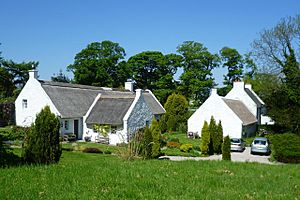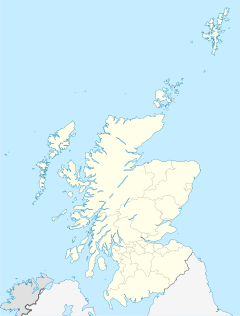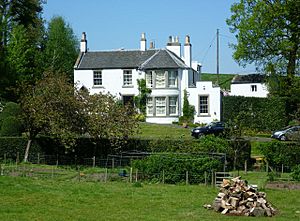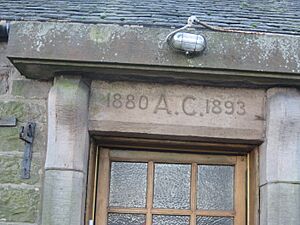Swanston, Edinburgh facts for kids
Quick facts for kids Swanston |
|
|---|---|
 Swanston Cottages |
|
| Population | 75 |
| OS grid reference | NT240672 |
| Council area |
|
| Country | Scotland |
| Sovereign state | United Kingdom |
| Post town | Edinburgh |
| Postcode district | EH10 |
| Dialling code | 0131 |
| Ambulance | Scottish |
| EU Parliament | Scotland |
| UK Parliament |
|
| Scottish Parliament |
|
Swanston is a small village and living area located on the southern edge of Edinburgh, Scotland. It is famous for its beautiful thatched cottages. These old houses are built around a village green, which is like a common grassy area.
Because Swanston is tucked away at the bottom of the Pentland Hills, it has stayed very peaceful. It hasn't been changed much by shops, businesses, or new housing developments. The village started in the 1700s. It was built to house the workers for Swanston Farm. This farm has been around since at least the 1200s! Swanston also helped provide fresh water to Edinburgh a long time ago.
One of its most famous residents was a young writer named Robert Louis Stevenson. His family rented a holiday home in the village in the late 1800s.
Contents
Where is Swanston Located?
Swanston is found on the southern edge of Edinburgh. It's just south of the Edinburgh City Bypass, which is a main road, and right at the foot of the Pentland Hills. The village is about 7.5 kilometers (4.7 miles) from Edinburgh city centre. It sits about 180 meters (590 feet) above sea level.
Swanston is part of the Pentland Hills Regional Park. It is also a special "Conservation Area." This means its unique character and history are protected.
The village is surrounded by trees, open farmland, and a golf course. You can only get to it by one paved road called Swanston Road. This road ends at a gate at the highest part of the village. Beyond the gate, the path becomes a rough track that leads up into the hills. Cars are not allowed in the very center of the village. These rules help keep Swanston a quiet and charming place. It feels a bit separate from the busy city.
It's important to know that there's also a newer housing area called Swanston. This was built in the 1980s and 1990s. It's located just north of the City Bypass. This modern area is separate from the old village. It is not part of the Regional Park or the Conservation Area.
What is the History of Swanston?
The name Swanston likely comes from an old Norse (Viking) phrase, Sveins tún. This means "Sveinn's enclosure" or "Sveinn's farm." The name first appeared in a document in 1214. It referred to Sveinn's farm within a larger area called the Barony of Redhall. Some clues suggest the farm might even be as old as the 800s!
In the 1300s, Swanston was mentioned in official papers signed by David II of Scotland. It was listed as land owned by the Knights Templar. These were a famous group of medieval knights who had settled nearby in the 1100s. More proof of the Templars' link to Swanston comes from a document in 1614. This paper, signed by James VI and I, listed all their Scottish lands, including "Templar lands of Swainstoun."
By the 1500s, the area had two large farms. They were on either side of a cart track, which is now Swanston Road. Easter Swanston belonged to the Ross family. Wester Swanston was first owned by Sir John Cockburn, then by the Foulis family. In 1670, the Trotter family of Mortonhall bought both farms. This united them under one owner.
The village we see today started to form in the early 1700s. A large three-story farmhouse was built. Then, a group of thatched cottages for farm workers and a schoolhouse were added. These buildings were placed around an open green with a small stream flowing through it. Later, in the late 1800s, eight stone cottages with slate roofs were built. They were arranged around another shared green.
By the mid-1900s, the thatched cottages were in poor condition. They still had dirt floors! Running water wasn't installed until 1934, and electricity didn't arrive until 1947. In 1956, Edinburgh's City Architect started a big project to fix up these cottages. They were rented out at first. Later, in the 1980s, many tenants bought their homes. Today, these are the only thatched buildings left in the Lothians area. The restoration work even won an award in 1964. The old farmhouse and schoolhouse have also been updated and are now private homes.
How Swanston Helped Supply Edinburgh's Water
From the 1760s, Swanston played a part in getting fresh water to Edinburgh. In 1758, a special law was passed. It allowed Edinburgh to take water from springs in the Swanston area. This was to increase the city's water supply.
The landowner, Henry Trotter, strongly disagreed. He said he needed the water for his own farm. Trotter even went to court to stop them. He lost his final appeal in 1760. So, Edinburgh went ahead and laid wooden pipes to carry water from the springs. They built a cistern house (a water tank building), sand filter beds, and a cottage for the water engineer. You can still see these buildings about 150 meters (164 yards) west of Swanston Road.
After the engineer's cottage was built, the city decided they needed another building. This would be a meeting place. So, a small, single-story thatched cottage was built nearby. This became known as Swanston Cottage.
According to Robert Louis Stevenson, the city leaders built the water house and pipes. Then, they realized the spot was great for parties! So, they quickly built a "Pleasure House" for city events.
Robert Louis Stevenson's Connection to Swanston
Between 1867 and 1880, Robert Louis Stevenson's family rented Swanston Cottage. They used it as a summer holiday home. By then, the house had been updated. It had a second floor, bay windows, an extra room, and a slate roof instead of thatch.
Young Robert Louis Stevenson often stayed at the cottage. He loved the quiet country life and how remote it felt. The time he spent there likely influenced his writing. It also shaped his love for nature and wild places. The house and its beautiful setting are thought to have inspired some of his famous stories.
Swanston Cottage itself appears in Stevenson's unfinished novel, St. Ives. In the story, the main character, a French prisoner of war, hides there after escaping Edinburgh Castle. He later gets help from two drovers (people who move livestock). These characters were probably based on John Todd, a Swanston shepherd. Stevenson and Todd were good friends for many years.
Stevenson's nurse, Alison Cunningham (nicknamed Cummy), also stayed with the family at Swanston Cottage. After the Stevensons stopped renting the cottage in 1880, she stayed in Swanston. She lived with her brother, who was the waterman. Above the door of the waterman's cottage, there's an old stone with "1880 AC 1893" carved into it. This remembers her time there. She passed away in 1913.
Swanston Golf Club's Story
In 1927, Miss Margaret Carswell, a well-known member of the Edinburgh Women's Athletic Club, wanted to play golf. However, it was very hard for women to join local golf clubs. So, she decided to create her own golf course just for ladies!
She leased land from Swanston Farm. Then, she designed a nine-hole course west of the village. Later, she reluctantly agreed to let men join. This was mainly because her own club members wanted it. Allowing men to join quickly increased the number of members. This allowed the club to expand to 18 holes and build a clubhouse. By 1947, there were 400 members, with men outnumbering women three to one.
From 1893 to 2013, another club, Lothianburn Golf Club, was located east of the village. One of its most famous members was Tommy Armour. He won several major golf championships in the 1920s and 1930s, even though he was partly blind from World War I. When Lothianburn Golf Club closed in 2013, Swanston Golf Club took over part of its course.
Swanston Today
Today, Swanston still feels quiet and far away from the city. The village doesn't have any shops, cafes, pubs, schools, or churches. There are no specific tourist attractions either. However, it's often busy with walkers. Many people pass through the village on their way to hike in the Pentland Hills. They especially like to climb Allermuir (493 meters) and Caerketton (478 meters).
The village has a small population, estimated to be about 75 people.
Swanston Farm is the biggest business in the area. Since the 1970s, the McClung family has owned the farm. They also own the land where the two golf courses are. The McClung family had been farming this land since the 1930s. In the early 2000s, farming became harder. So, the family decided to try new things. They turned the old farm buildings into holiday cottages for rent. They also created small business units. These are located north of the village center, on the west side of Swanston Road. In 2007, the McClungs opened a restaurant called the Brasserie. It's located at the Swanston Golf Course's clubhouse.
Swanston Farm is also home to the Edinburgh University Exmoor Pony Trekking Section. This is a group run by students. They organize pony treks for both students and the public.
Future Plans for a Leisure Complex
In 2019, a company called Hillend Leisure Ltd. announced plans for a large leisure complex. This would be built on the land of the former Lothianburn Golf Club, south and east of the village. The plans include mountain bike trails, a zip wire, a campsite, glamping pods (fancy camping tents), a pump track (for bikes), offices, shops, and a cafe.
However, a group called "Friends of Swanston" is against this project. They say it would harm the wildlife and their homes. They also worry it would cause more noise, litter, and bad behavior. They believe it would lead to traffic jams and change the quiet feel of Swanston village. They are also concerned it would set a bad example for building in protected conservation areas.






